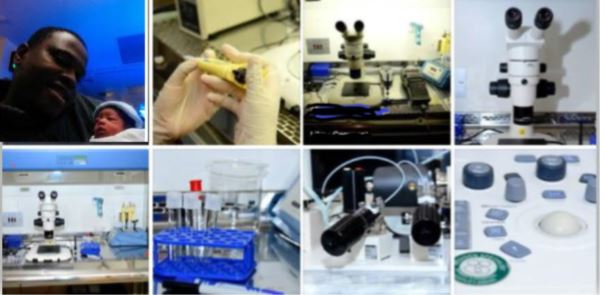Genome Editing CRISPR-Cas9 technology and In Vitro fertilisation (IVF)
Lateef Akinola, PhD, FRCOG
What will the world be now without IVF? Thanks to all IVF pioneers and today’s diligent practitioners. Will genome editing techniques to create “designer babies” make rubbish of the progress and successes made so far using assisted reproductive technologies (ART)?
IVF research started over 40yrs ago, culminating in the birth of Louise Brown, the first IVF baby, in 1978 in Oldham, United Kingdom. Since then IVF/ ART to treat infertile couples have grown by the leaps – in terms of innovations and developments in clinical applications, assessments and treatment modalities. Other areas of IVF treatment methodologies that have witnessed increased modernization in clinical effectiveness include patient handling, medications, laboratory equipments and embryo culture media.

Offshoot developments in ICSI, PGT-A/PGT-M (preimplantation genetic testing for aneuploidy/monogenic diseases), NGS (Next Generation Sequencing) and other areas like DONOR SERVICES, SURROGACY, 3-parent embryos, embryoscope technologies and CRISPR-Cas9, to mention a few, has broaden the horizon of treatment modalities; bringing succor and happiness to innumerable couples who are now proud parents. As a result, the success rates of IVF outcomes have increased dramatically, leading upto about 8 million babies born so far since its inception.

Always, there have been a background fear of using the IVF technology to create tailormade babies or so called ‘designer babies’ with bespoke new traits, like intelligence, height, colour of eyes, disease susceptibilities etc. IVF/ART combined with CRISPR-Cas9 techniques has made this a reality.
CRISPR-Cas9 is a genome editing technique reported in 2012, making it possible to alter or customize DNA genetic codes of living beings. With this reality coming to fruition, a number of research organisations, scientific communities, governmental bodies and the society at large have clamored for a moratorium on human gene editing (to create designer/bespoke babies). This moratorium should be applied universally, until the full genetic indications, implications and the issues concerning the welfare of the unborn child and any attributable social consequences and the governance structures of this novel technique have been diligently verified. Furthermore, there should be wide societal discussion and acceptance of the ethics and morality of gene editing before its full unhinged clinical applications. Such applications include prevention and permanent cure of inheritable autosomal or sex-linked genetic diseases that could be easily passed to future generations.
Inappropriate and unregulated usage of CRISPR-Cas9 techniques have inherent potentials for mistakes which may portend danger and create a Frankenstein. These mistakes can arise from off-target editing i.e. inadvertent editing of unrelated or unplanned segments of the DNA/chromosomes with unintended transient or permanent dire consequences to the created individual and humanity. Other sources of errors with unknown consequences includes MOSAICISM, where the DNA alterations does not appear in all somatic or germline cells so altered. These mistakes could bring forth untold detrimental, pathophysiological consequences for the created individual. Nobody knows what impacts these errors will have in the long run to the created individuals’ health, lifespan and genetic evolution.

So, the scientific community and the society at large were exasperated when Dr Jiankui He from China’s Southern University of Science and Technology, unexpectedly and prematurely announced the creation of twin babies using CRISPR-Cas9 to purportedly edit out the human gene CCR5 that makes human susceptible to HIV infection. Even though, Dr He is most likely aware of a number of inexpensive and clinically effective methods to prevent vertical/horizontal transmission of HIV from parents to child.
At present, solutions are not yet found on how to prevent consequences of mosaicism and off-target editing errors that could cause fatal genetic and irreparable mistakes when human genome are artificially edited. Also, the impact and consequences on the present and future human generations are largely not yet evaluated. There should be a strong and enforceable moratorium on the use of CRISPR-Cas9 and other gene editing techniques in humans before it becomes acceptable and widely applicable.
The society most likely will welcome ethical and intelligent usage of gene editing CRISPR-Cas9 to ameliorate and cure diseases in animals and specifically in humans. Thus, inheritable genetic diseases like sickle cell, thalassemia, cystic fibrosis, cancers and other neurodegenerative disease can be cured. However, clinical application of this technological innovation, CRISPR-Cas9 genome editing techniques, should await further perfection of its clinical indications, applicability and analyses of its full impact on humanity as whole.